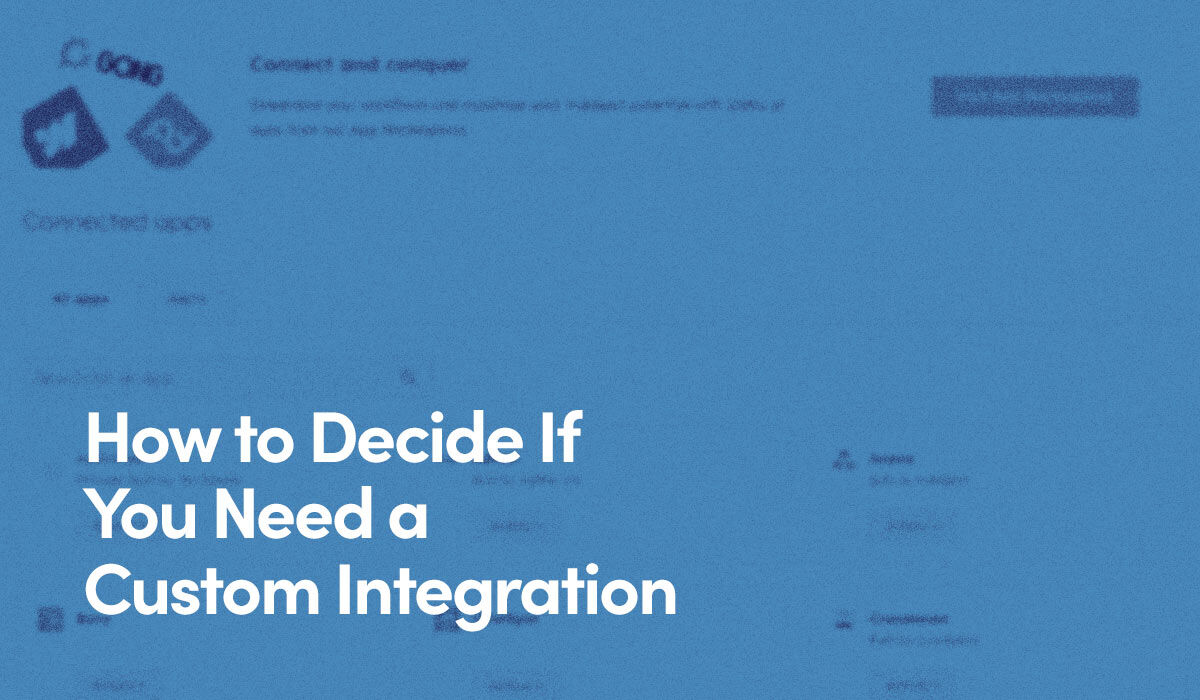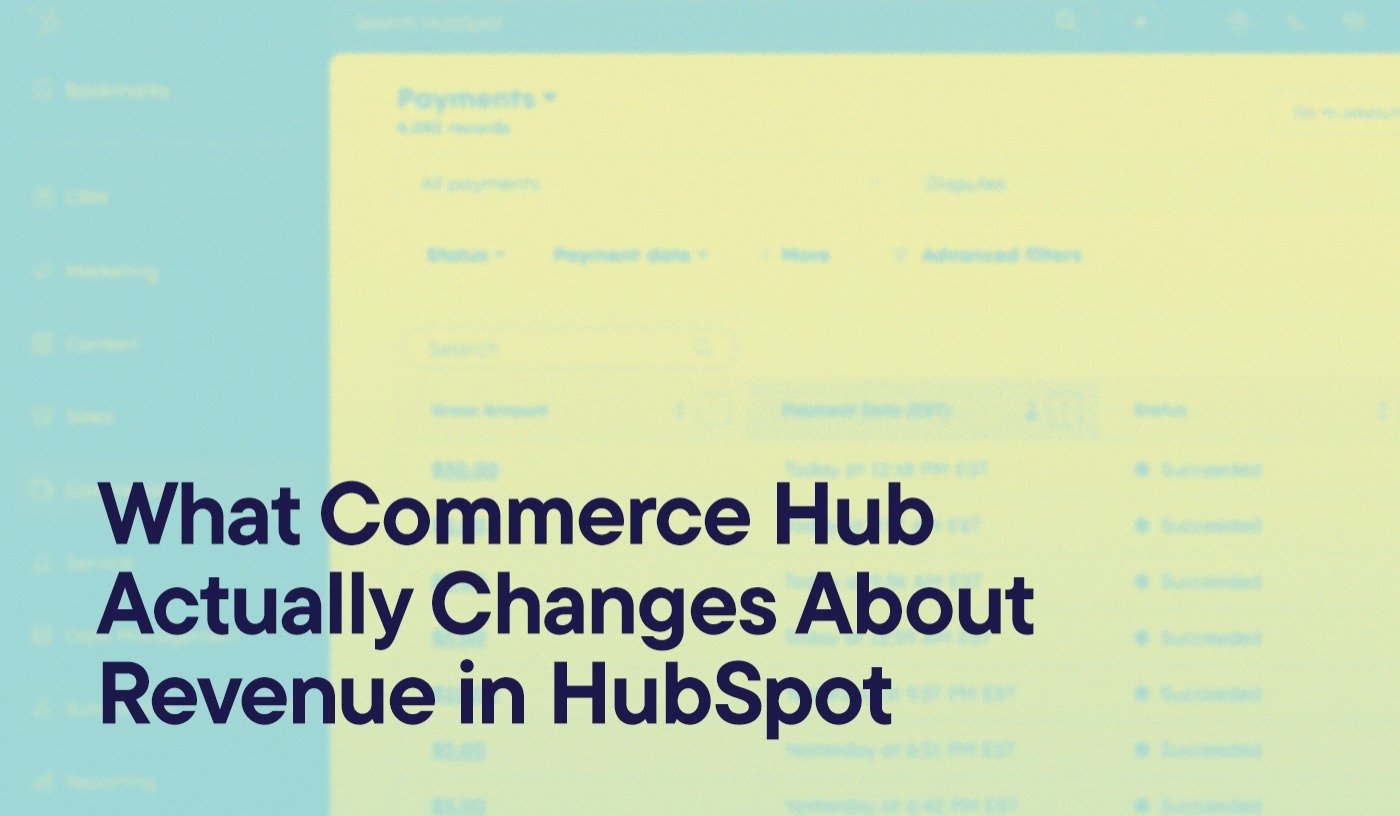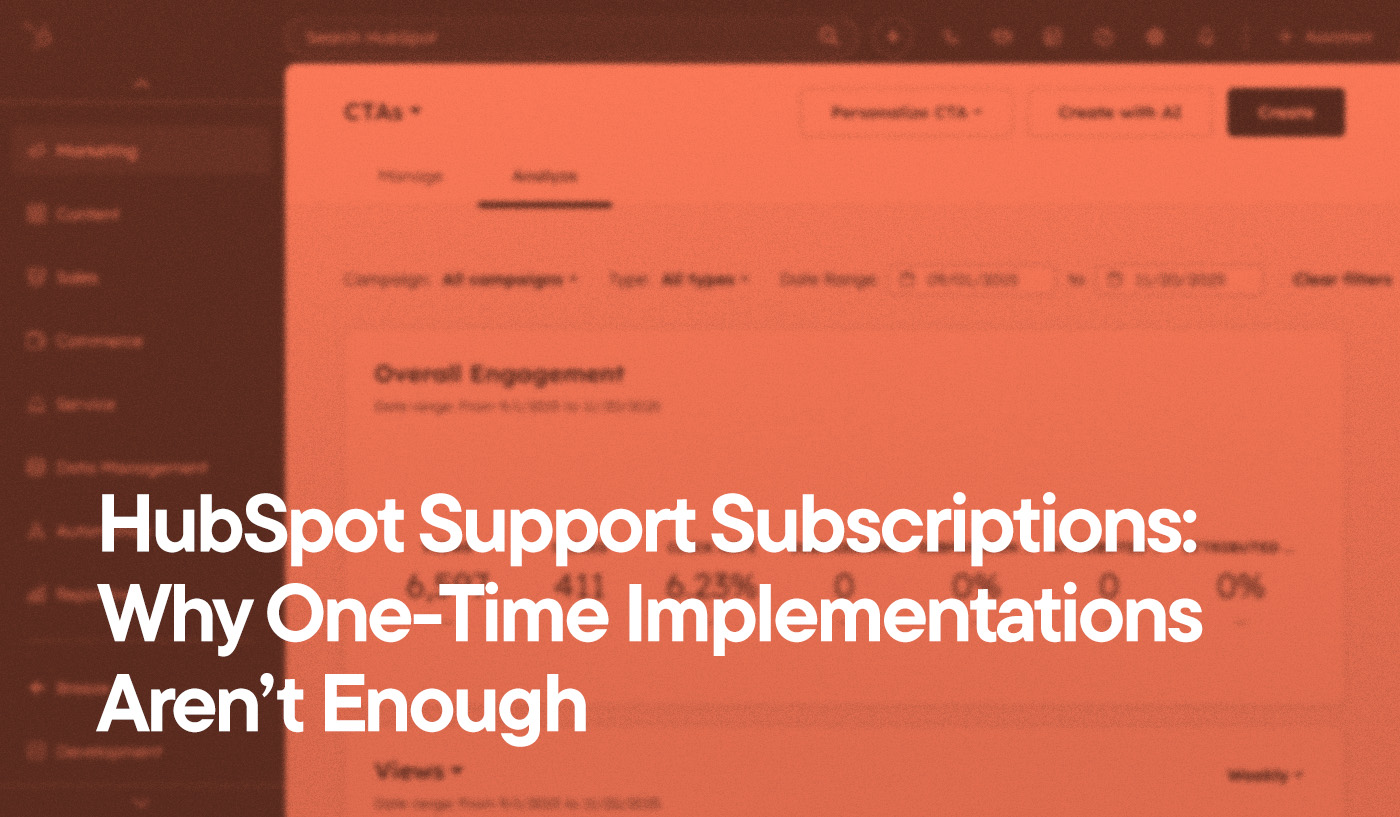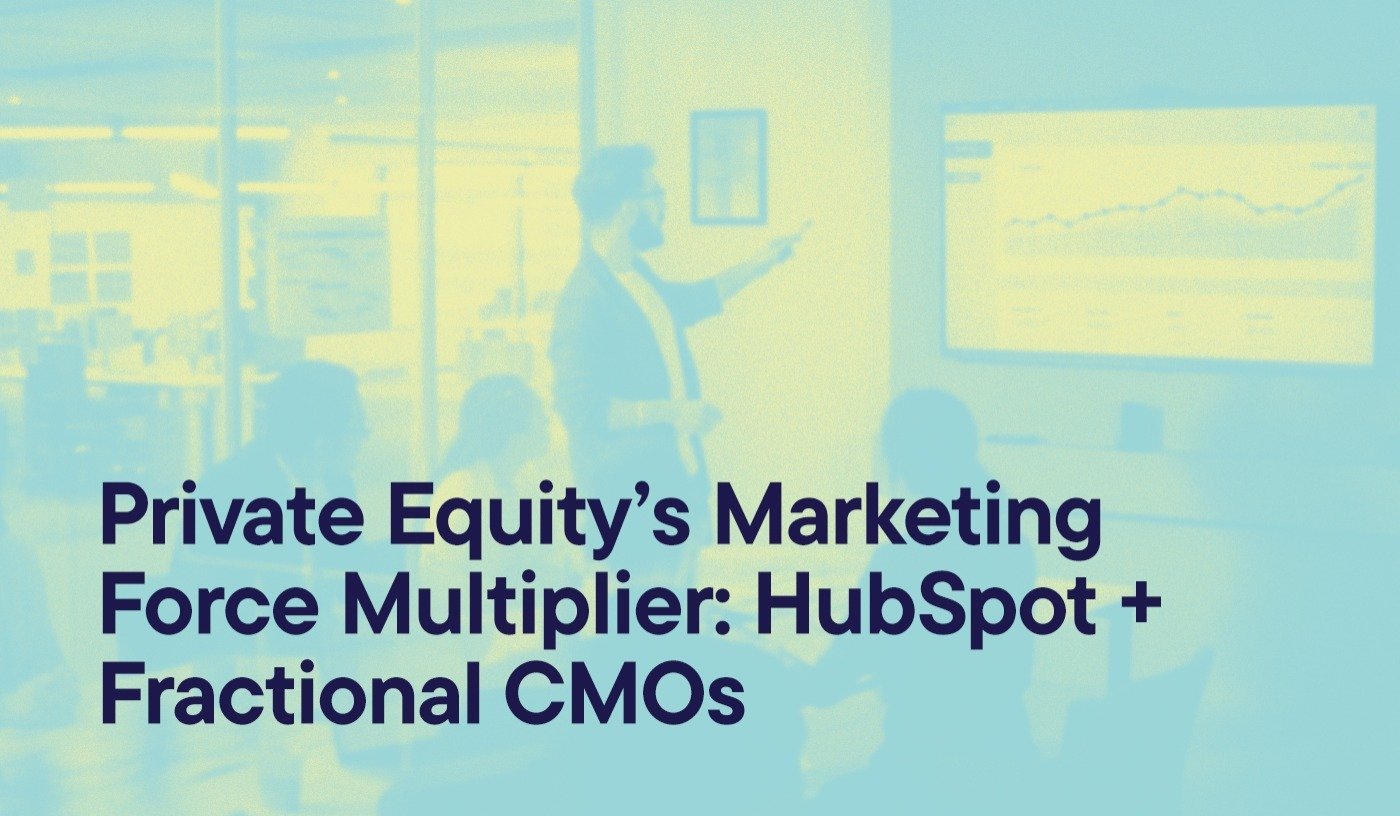As we’re all witnessing, tech stacks are growing increasingly more complex each year, with new apps built upon others. At the same time, APIs are doing their best to ensure everything flows together neatly.
When it doesn’t, your efficiency plummets. Data becomes corrupted or fractured. Team members get frustrated. And you begin losing customers.
What we’ve found is that out-of-the-box solutions from HubSpot can help. But sometimes you need a custom integration to establish a seamless connection between your various applications and software systems.
This guide will help you determine whether you should go with a custom integration or choose a standard fix.
What Is a Custom Integration?
A custom integration connects two apps when a pre-built solution doesn’t exist, or has limited functionality. In other words, custom HubSpot integrations are essential when standard ones don’t meet your specific needs.
Custom integrations are powerful tools for connecting unique or niche applications directly to HubSpot.
For instance, we built a custom integration between one of our client’s apps and HubSpot, creating a contact anytime someone filled out a particular HubSpot form.
We’ve also forged similar custom integrations with other apps, including Expert, Daysmart, Discovery Data, Stripe, Constant Contact, and Global Shop.
Honestly, the possibilities with integrations are endless when custom-built.
Common Reasons for Building a Custom Integration
Let’s look at just a few of the major reasons organizations turn to custom integrations.
Concerns surrounding siloed data are, perhaps, the most common. The manual data entry required to copy data from one app to another by hand takes time. It’s a pain for teams, and it opens the door wider to human error.
Alternatively, siloed data can be integrated for greater efficiency and data sharing using automated processes.
For instance, we connected a client’s HubSpot to the app Retool, enabling their team to quickly score an athlete’s technical assessment into a proprietary mobile app. This, then, synced to HubSpot every night through our integration.
This meant their team could spend time with and focus on the athletes enrolled in a soccer program, instead of spending endless hours manually entering scores.
Custom integrations bridge the workflow voids left by standard solutions. For example, an out-of-the-box integration may only sync certain data fields. This is a problem when more info about a contact/company/deal is needed across multiple systems.
Outdated legacy systems may require custom connectors to integrate with modern apps or software that were created with more advanced software. For example, a subset of clients may use Twitch streams, which don’t directly integrate with HubSpot.
You may need a custom integration if analytics and insights are insufficient. For instance, some external reporting tools in other systems may tell you how a contact interacted with an externally hosted asset, but they may not show you how that interaction impacted the buyer’s journey.
Related: Maximizing ROI With HubSpot: The Value of Custom Integrations
4 Key Reasons to Build a Custom HubSpot Integration
• Automate data sharing
• Reduce manual data entry
• Minimize human error
• Example: Syncing athlete scores from a mobile app to HubSpot
• Sync additional data fields
• Connect information across multiple systems
• Customize data flow to your needs
• Bridge old and new technologies
• Gain deeper understanding of customer interactions
• Track impact on buyer’s journey
• Combine data from multiple sources for better reporting
Key Takeaway: Custom integrations tailor HubSpot to your unique business needs.
Deciding If You Need a Custom Integration
We know it’s a challenging decision.
If you’re doing it right, determining whether your organization needs a custom integration with HubSpot will involve evaluating current workflows, business needs, and the potential costs and benefits.
Before you choose to build one, ask yourself a few questions:
- Is there a pre-existing integration that can solve your problem?
- Does that integration do everything you need?
- Can you achieve your goals by adding a different piece to your tech stack or replacing a piece?
- How mission-critical is this integration?
- How much time/effort/money is a custom integration likely to save you?
As you contemplate those questions, here’s a structured approach to help you make that decision:
1. Assessing Current Workflows & Needs
Identify all your present pain points. Look at your current processes and identify any inefficiencies or gaps that a custom integration could improve. Time spent manually entering data invites human error. It’s time-consuming, too. Perhaps you’re paying too much for a solution that’s not working well.
List specific system requirements or feature capabilities. Determine if there are specific functionalities or data flows that a standard HubSpot integration cannot handle. Some behaviors are not available with pre-built solutions. For example, a data sync may only happen once per day or week. However, your custom solution may be able to sync data immediately using webhooks.
Gauge your organization’s scalability. Consider whether your current systems can scale with your business growth or if a custom integration is necessary to support future needs. Teams may have subscription-based restrictions, for instance, that prevent them from accessing data through an out-of-the-box solution.
2. Weighing the Benefits of a Custom Integration
Anticipate newfound efficiency gains. Calculate the time savings and productivity improvements that a custom integration could bring you. While it varies from situation to situation, we’ve seen teams that manually export/import data from one app to another every day.
That means one team member spends 30 minutes to an hour syncing their apps daily. That’s between two and a half and five hours a week—or more than 22 hours a month.
So, while the daily time savings may be small, when we consider the advantage we can gain across the span of a year, it becomes clear the investment can be worthwhile.
Look forward to improvement in your data accuracy. Assess how an integration could improve your data consistency and accuracy across different platforms.
Again, an out-of-the-box integration may do a data push once a day, whereas a custom integration could be configured to run multiple times daily. One example may be calling a list of clients and inviting them to an event. Without an up-to-date list of who has already been called, some contacts may fall through the cracks.
Your team is going to revel in the enhanced user experience. Think about how the integration might augment your teams’ user experience, making it easier for people to access and utilize data. That’s gonna boost team morale, as well.
For instance, we regularly create in-app modules that a user can click to automatically sync and pull info from external databases and systems. This is an “enrich” module that, when clicked, pulls everything we know about a contact from an external database.
Connect Multiple Platforms Seamlessly
Is a HubSpot Integration Right for Your Business?
Explore Custom Integration Solutions arrow_forward
3. Considering the Costs of Developing a Custom Integration
Pin down your development expenses. Estimate the costs of developing the custom integration, including hiring developers or consulting with an integration partner. You’ll have to pay for the developer who builds the solution. Sometimes that includes multiple developers if your project needs to be fast-tracked.
Don’t overlook your maintenance costs once the custom integration has been built. Account for ongoing maintenance and support expenses to ensure the integration continues to function properly as both HubSpot and your other systems update.
It’s going to require training and adoption. Team members will need to learn how the new integration impacts their current workflow. Consider the costs associated with training them on the new system and the time it will take for them to adapt to new processes.
4. Analyzing Upheaval & Adoption Costs
Don’t forget to plan for temporary disruptions to your team and systems. Be certain you understand the potential short-term disruptions during the integration period and how they might affect day-to-day operations.
Things can get a bit bumpy without a transition strategy. Plan for a change in management strategy to help your team transition smoothly. This might include training sessions, documentation, and continuous support.
Ensure all team members are positioned to successfully adapt. Consider how quickly your team will adopt the new system and become proficient with it. User adoption can significantly impact the overall ROI of your custom integration.
5. Comparing Alternatives to a Custom Integration
Native integrations may already have what you need. Before committing to a custom solution, thoroughly explore existing native integrations and third-party tools that might meet your needs with less complexity and lower cost. For instance, HubSpot has a pre-built stripe integration. We frequently remind clients to avoid trying to reinvent the wheel.
Look for more straightforward options first. Evaluate whether simpler solutions, like improved manual processes or minor adjustments to existing tools, could address your needs without a full custom integration.
6. Calculating Your Potential ROI
Here’s where you dig into the actual numbers. Conduct a detailed cost-benefit analysis, comparing the costs (development, maintenance, training) against the expected benefits (efficiency, accuracy, user satisfaction).
Do your best to quantify. Look at the startup costs to get an integration going, factor in the maintenance costs, and price it against out-of-the-box solutions. And don’t forget to account for manual time.
Keep your eyes on the big picture. Consider the long-term value and potential competitive advantage a custom integration could provide.
7. Pilot Testing
Creating a proof of concept can save you time and money. If possible, start with a pilot project or proof of concept to test the integration on a smaller scale. This can provide valuable insights and help you make a more informed decision before you scale up the integration.
Start small with a few properties that sync via an API. If it works for a few properties across multiple instances, continue to expand and test at larger and larger scales. For example, you can update all info about customers in Delaware, and eventually get to California, which will have the largest sample group.
To Build a Custom Integration or Not
Deciding whether to pursue a custom integration with HubSpot is a complex decision that requires a thorough understanding of your organization’s needs, an evaluation of the potential benefits, and a careful consideration of the costs and risks involved.
However, if you follow this structured approach, you can make a well-informed decision that aligns with your business goals. And you can be confident you’re maximizing the value of your technology investments.
Reach out to us today to find a HubSpot integration solution that’s right for your company.




